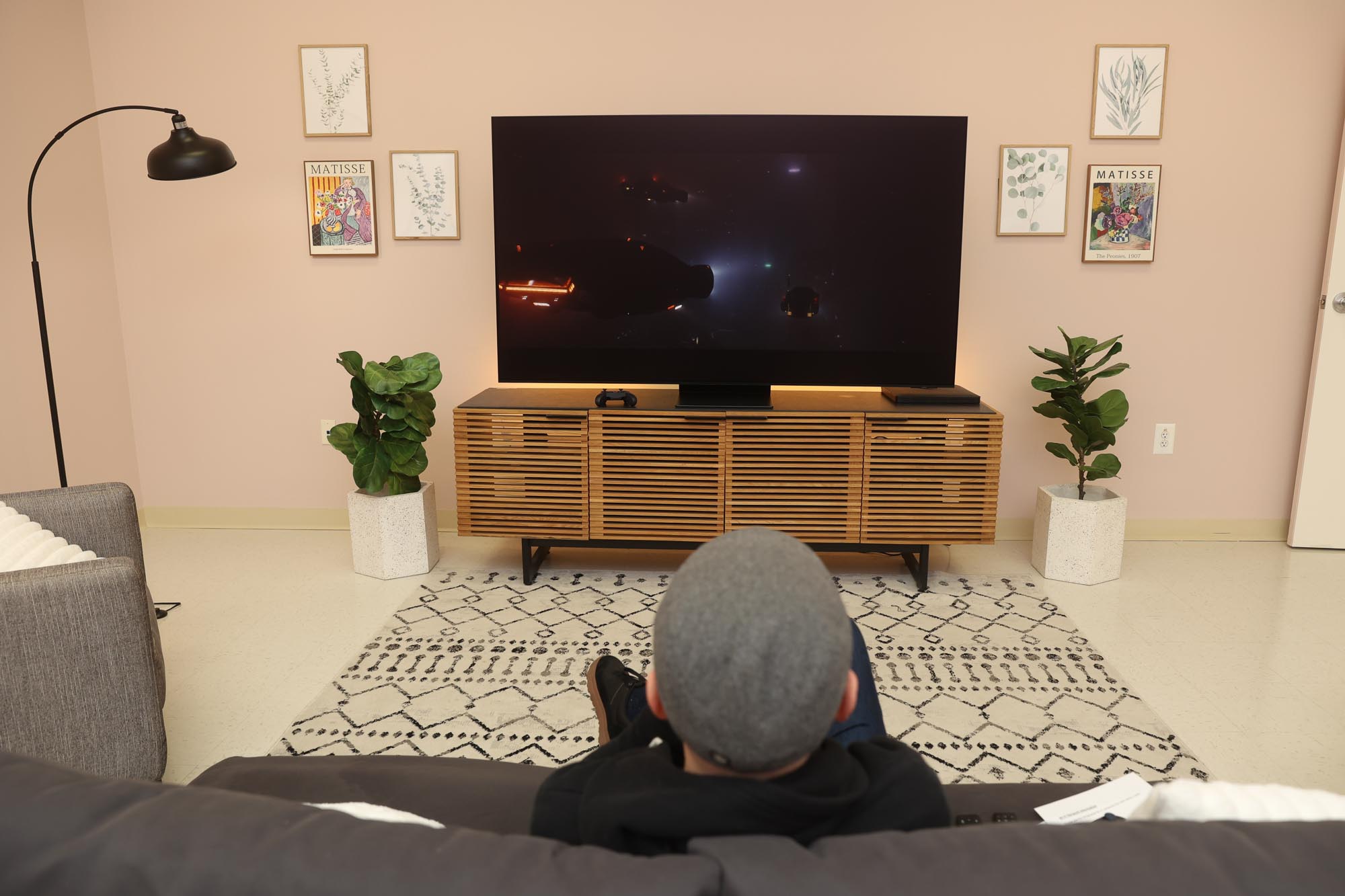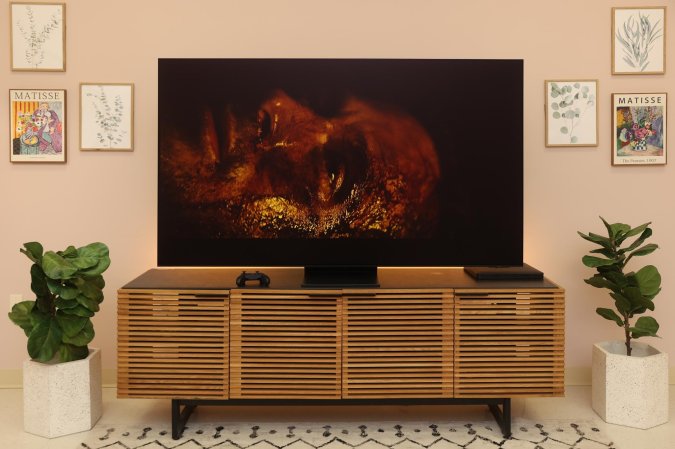

We may earn revenue from the products available on this page and participate in affiliate programs. Learn more ›
We recently had the opportunity to spend a day with Samsung’s 2024 TV offerings, as well as its updated HW-990D soundbar and new Music Frame speakers. Overall, the 2024 lineup isn’t a revolution from the 2023 offerings, but the company has placed a clear influence on AI capabilities for features like upscaling and analyzing audio in order to emphasize dialog so it’s easier to hear through ambient noise.
To test the TVs to the best of our ability, we spent some time streaming content with the built-in Tizen OS smart TV apps, including Netflix and other popular streaming services. We also used 4K Blu-ray copies of Alien and Blade Runner 2049 to test Ultra HD playback.
Here are some first impressions about the new gear, with more in-depth reviews to come down the line:
S95D OLED 4K TV
LG has historically dominated the OLED segment of the TV market, but Samsung took a big swing with last year’s S90C. It offered all the poppy contrast and deep black levels you’d expect from an OLED, adding amplified brightness to make it more watchable in a bright room. Now, Samsung has introduced its successor, and it is making even more strides to battle back against bright environments.
The S95D employs an impressive glare-resistant matte coating to reduce reflections that can ruin your watching experience. Glare can be especially problematic for OLEDs since they typically can’t achieve the same brightness levels QLEDs or even typical LEDs provide. During our time with the S95D, we were very impressed with the brightness, color gamut, and anti-reflective properties. Shining a lamp directly at the screen from just a few feet away created a dull blob of illumination rather than a clear image of the lamp or a well-defined specular highlight (a bright light source reflecting directly back at the viewer from within the frame).

The demo room where we watched the TV had ample ambient light, but we could still clearly make out details in dark scenes from most angles. The Pantone-validated screen predictably excels with the lights off, but the daylight performance was truly impressive. That doesn’t come as too much of a surprise as Samsung has been honing its anti-glare screen tech for years with its design-oriented Frame-series TVs.
We spent most of the demo watching 4K Blu-ray content in Cinema mode. And while that’s our preferred mode for most content, the overall picture does benefit from a little bit of added brightness. If you’re blacking out your room completely, Cinema mode may be fine, but those dark OLED blacks everyone loves so much can still get a little too black without a little tweaking.

Overall, we were very impressed with the S95C, and the S95D seems like a very worthy successor. It maintains the gaming-friendly “Motion Xcelerator” 144Hz maximum refresh rate with 2.0ms lag (only available in specific modes); Samsung’s smart TV features; support for HDR10, HDR10+ (adaptive and gaming), and hybrid log gamma (HLG) HDR profiles (but still no Dolby Vision on any Samsung sets); and very fast upscaling thanks to the new NQ4 AI Gen2 Processor.
It’s available in 55-, 65-, and 77-inch models and is currently up for pre-order.
QN900D Neo QLED 8K TV
While the OLED TV is flashy, the QN900D 8K TV is Samsung’s true flagship and offers the top-end bells and whistles you’d expect. Samsung is touting its new AI-based upscaling powered by the NQ8 AI Gen3 Processor. Upscaling acumen is crucial in this case since you don’t really have any native options for 8K source material at the moment. You’ll always be upscaling no matter what you watch.
We got the chance to check out the 65-inch mode, and the 4K Blu-ray content looks spectacular, as you might expect. From an appropriate couch distance (roughly 6 to 8 feet), I don’t think the average person will notice an appreciable difference from a typical 4K display, thanks to the algorithm-based upscaling, motion-tracking (particularly useful for sports), “Motion Xcelerator” 240Hz refresh rate, and Auto HDR (with the same profiles as the S95D). The image is bright, the colors are simultaneously vivid and accurate, and it provides an overall excellent picture. Is it overkill for most people? Sure. But that’s always been part of a flagship experience.

The panel itself is one of the most impressive parts of the whole experience. All of the HDMI 2.1 ports, etc., reside on a remote box connected by a single wire, which is something Samsung has been doing with many of its high-end TVs for a while now. (The S95D above also has a “One Connect” box.) Thanks to its flexibility, installation is relatively simple. The panel itself is wildly thin with a barely noticeable bezel (Samsung calls it the “Infinity Air Design”). In a darkened room, the image looks like it’s floating.

Despite its diminutive thickness, this flagship TV provides fairly impressive sound. You’re still going to want a soundbar or some other home audio setup to do justice to the image, but the onboard 6.2.4-channel speaker system does an admirable job right out of the box. The TV supports Dolby Atmos with its built-in sound system. The directional audio is subtle compared to a dedicated system, but it is noticeable if you’re paying attention. The TV tracks objects as they move across the screen and tweaks the sound output to mimic the movement.
It comes in 65-, 75-, and 85-inch configurations and is currently available for pre-order.
QN90D Neo QLED 4K TV
This is Samsung’s bread-and-butter QLED 4K TV. It eschews 8K but comes in a wider variety of sizes, including 43, 50, 55, 65, 75, 85, and a massive 98 inches.
The backlight includes Quantum Matrix Mini-LED technology, which allows for hyper-local dimming. It can’t quite reach OLED levels of contrast, but it does offer considerably more brightness, which is crucial if you’re battling lots of ambient light. I did notice that specular highlights sometimes cause a curious red, green, and blue halo effect on the screen. It’s not a problem in most settings, but it’s noticeable if you have a light directly near the TV, especially if you’re off the center axis.
Generally, though, the TV performs excellently. The extra brightness from the Mini-LEDs makes the Filmmaker Mode usable in just about any lighting situation. I still prefer a little bit of added brightness, but if you’re in a pitch-dark room with eyes adjusted to the dark, you can really appreciate the subtlety.
The QN90D’s processing hardware isn’t as robust as the flagship’s chip, but it doesn’t need to be since it’s not on constant upscaling duties. You do, however, still get the AI-powered features. The voice enhancement tech really does make it easier to understand people when they’re speaking on-screen. And once again, the Dolby Atmos performance provides noticeable directionality without any extra hardware.
We’re looking forward to spending more time with a review unit, during which we can test it in a wider variety of settings. If you want to try one before we do, every size except the 98-inch is currently available for pre-order.
HW-990D Soundbar
While Samsung’s TVs have received noticeable upgrades and improvements, the company’s flagship soundbar for 2024 is similar in many ways to the 2023 edition. But that’s not a bad thing. This celebrated Dolby Atmos soundbar’s hefty hexagonal hardware (say that five times fast) still delivers 7.1.2 channels when paired with its wireless subwoofer. And that channel count continues to expand to 11.1.4 when you add in the optional wireless rear satellites with their additional upfiring drivers (the configuration we wholeheartedly recommend).
The soundbar remains 48 inches long (fitting between the width of 55- and 65-inch TVs), 2.7 inches tall, and 5.4 inches deep, so measure your credenza/media stand pre-purchase. Within that 17-pound enclosure are 15 front-facing, side-firing, and top-mounted drivers in total. The sub is relatively slim for its 26 pounds, housing an 8-inch driver with a rear port and a distinctive acoustic lens. The two 7-pound satellites, which each require a power output, share design language with the soundbar’s metal grille. It’s still a Wi-Fi-enabled setup, with AirPlay 2/Chromecast/TIDAL Connect/Spotify Connect for network music streaming, as well as support for Bluetooth 5.2 for less advanced-resolution content. As for the system’s differences, the 990D’s ports are now HDMI 2.1 with 4K 120Hz passthrough and VRR, which is great for gamers.

Just because the 990D looks the same doesn’t mean it sounds the same, however. Thanks to AI (the buzzword at CES 2024 in January), the 990D has “SpaceFit Sound Pro,” an auto-calibration system that analyzes room surroundings for optimal response based on the layout of soundbar, satellites, and sub. In addition, a new Game Pro mode promises to adapt playback to different game profiles (FPS, racing, RPG, etc.). Oh, and a pro tip: Make sure the TV is set to properly passthrough bitstream audio so that the soundbar can properly decode it (a setting we had to tweak on the demo unit after an initially confusing, underwhelming minute).
We didn’t get any gaming in, but we did cycle through several Dolby Atmos albums (Rage Against the Machine’s self-titled debut was a pummeling highlight), as well as select scenes from Blade Runner 2049. There’s a sequence in the film where cars, flying through a violent storm, crash land at a seawall. Parts of the action take place above and below water, featuring immersive, operatic sound design alternating between claustrophobic and crescendo. Our general takeaway was that the 990D extracted even more intent and impact than the already impressive 990C. Even when the ambiance was meant to be crushing, there was clarity—precise imaging and clear dialogue aided by the Q-Symphony synchronization of sound and on-screen action. The subwoofer, given a thorough workout, never felt overwhelmed. The overall experience was never just a case of everything being louder; it was an ability to make everything feel larger. From flyovers to drum fills, the 990D deftly rendered a sense of spaciousness and dynamic tension.
Sound like something you’d like to hear? The HW-990D is available to purchase now.




